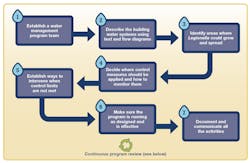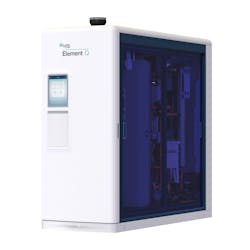Effective Water Management Programs
By Conrad Jahrling and Scott Alford, Watts Water Technologies
Legionella is a leading cause of waterborne disease outbreaks in the United States and cases are on the rise (Figure 1), according to the Centers for Disease Control (CDC).[i] An estimated 10% of reported Legionellosis cases are fatal and outbreaks cost facility owners more than $1 billion annually, on average, due to lawsuits, treatment, and lost work hours.[ii] Fortunately, facility owners have a highly effective tool to prevent such dire consequences: a water management program.
Water management programs for large buildings in the United States are included in ANSI/ASHRAE Standard 188 framework to proactively manage building water systems and reduce the potential for Legionella growth.[iii] The standard defines major elements associated with Legionnaire’s disease, including:
- Types of buildings and devices that need a water management program
- Minimum components of a water management program
- Devices (water heaters, cooling towers, shower heads, etc.) to prevent the growth and spread of Legionella
Creating an Effective Water Management Program
According to the CDC Toolkit, a water management program (Figure 2) should identify areas or devices in a facility where Legionella might grow or spread to reduce potential outbreaks. A water infection control risk assessment (WICRA) process should be an essential element of a water management program.
A WICRA is used to evaluate water sources, modes of transmission, occupant susceptibility, occupant exposure, and program preparedness. It can assist in prioritizing water management activities, such as monitoring and mitigation efforts. A WICRA is recommended to be conducted during the initial development of a water management program and updated periodically.
Thermal Disinfection
An effective water management program integrates thermal disinfection as a form of remediation. This age-old method has proven to be highly effective against bacteria, protozoa, and viruses found in water, wastewater, and other media. A major factor is that thermal disinfection is not impaired by turbidity, natural organic matter, water hardness, or pollutants such as metals.
Thermally sanitizing volumes in water heaters and tanks are periodically necessary. Over time and depending on use, thermal stratification causes water at different temperatures (and therefore densities) to create a distribution of temperatures from top to bottom of a tank. Raising the average tank temperature and circulating water within the volume can de-stratify and disinfect the volume. Doing this on a regular, programmed cycle with a circulating pump and an ASSE 1017 master mixing valve downstream is a best practice.
Material selection in the entire domestic hot water delivery system is a critical factor due to the elevated temperatures necessary for thermal disinfection. Some water heater equipment is designed with an engineered material that blends austenitic and ferritic steels to combine the advantages of 300 and 400 series stainless steel and is extremely strong and highly resistant to aqueous corrosion for a longer lifespan. ASHRAE provides guidance for other parts of the domestic hot water system, as well.
Water Heating System Considerations
Thermal disinfection is only one part of effective Legionella mitigation. A program should also integrate the proper equipment, technologies and control capabilities of the facility’s water heating system.
Key aspects to consider when selecting which solutions best support waterborne pathogen mitigation efforts include:
System Supply and Recirculation Treatment – Treating the inlet water can significantly reduce the risk of introducing pathogens into the building water system and scale-forming minerals in the water that facilitate pathogen growth within the system. Certain solutions, such as shown in Figure 3, take a multi-stage process consisting of scale prevention followed by sediment filtration, UV disinfection, and regular tank volume blowdown cycles.
An anti-scale solution reduces surface scale formation, so biofilm has fewer low-velocity surfaces to affix. If sediment accumulates within a water heater tank, regular blowdown cycles can remove potential biofilm at the base of the tank. Sediment filtration can help prevent that.
It is also a critical next step to ensure the effectiveness of the UV disinfection, as sediments may block the UV light from reaching pathogens. The UV disinfection should provide a 6-log reduction at the design flow rates by inactivating Legionella bacteria for effective treatment.
As the water returns from the building system, a two-stage treatment process of sediment filtration followed by UV disinfection can greatly reduce the risk of sediments and pathogens found in the plumbing system entering the water heater system.
ASHRAE 188 Documentation – Part of the compliance of a facility’s water management program with ASHRAE 188 is to demonstrate the implementation of ongoing control measures and any corrective actions taken. This includes tracking relevant data and logging events, such as temperatures, disinfection, maintenance, UV functionality, and more. While time consuming, it is a critical element. Fortunately, solutions exist with advanced control systems that collect this data and let personnel easily log activities to simplify compliance measures.
Conclusion
To reverse the growth in Legionellosis cases, contractors must implement water management programs that outline processes to monitor and ensure water quality. This should include the consideration of water heating system designs with features, in terms of technologies, materials and software that enhance and simplify water management efforts.
Conrad Jahrling is Product Manager for Water Wellness at Lync by Watts. He has been in the plumbing and HVAC industry for 15 years, taking products from concept through commercialization and code adoption.
Scott Alford is the National Account Manager for the Healthcare sector for Watts Water Technologies and has over 30 years of mechanical equipment experience in commercial and industrial markets. Scott has been certified as ASSE 12080 Legionella Water Safety and Management Specialist.[i] https://www.infectioncontroltoday.com/view/preventing-waterborne-pathogen-transmission https://www.cdc.gov/healthywater/surveillance/burden/findings.html
[ii] CDC VitalSigns, June 2017
[iii] ASHRAE Standard 188-2021. Legionellosis: Risk Management for Building Water Systems



